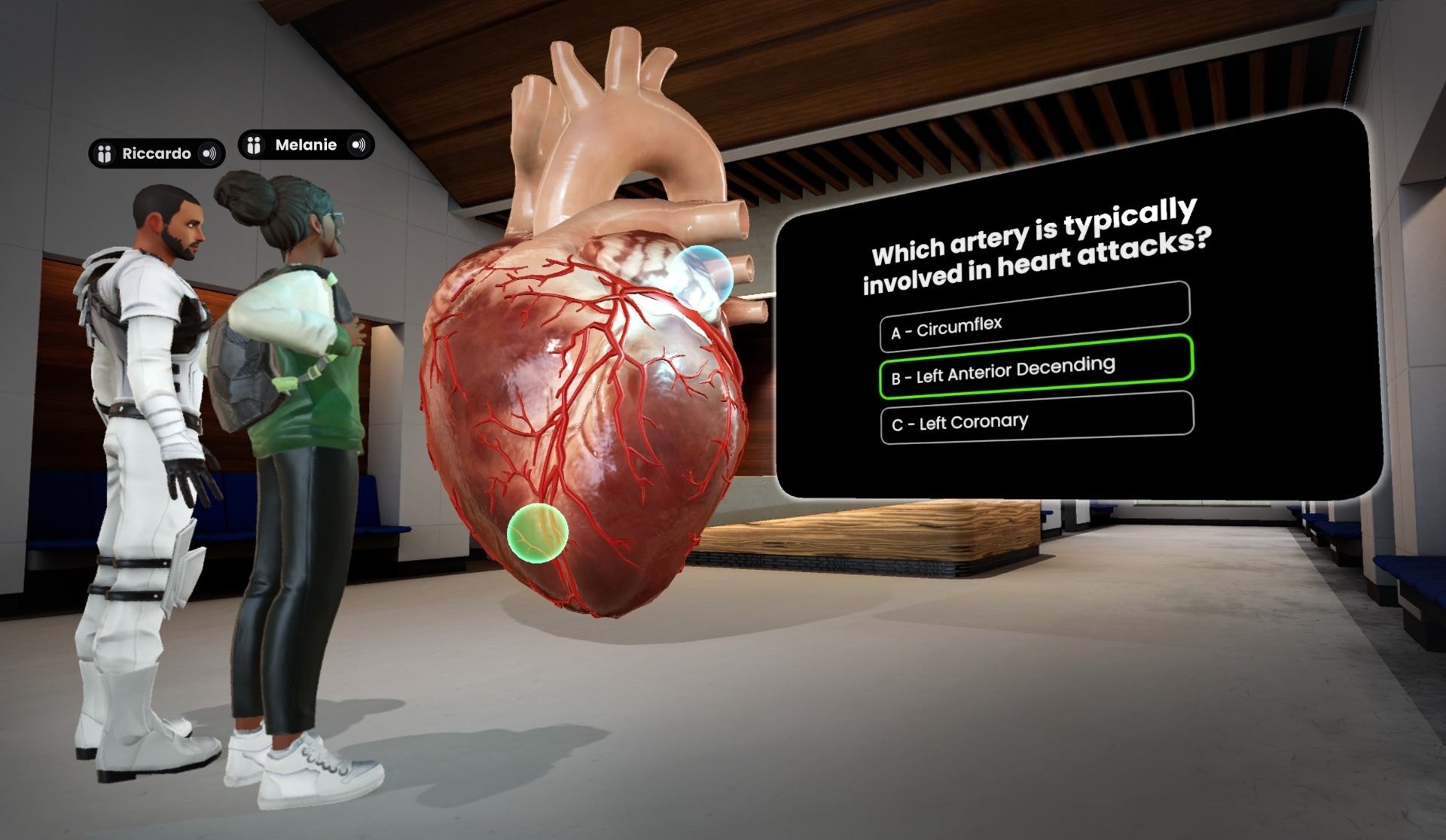As we address the challenges in online education, interactive 3D social platforms have emerged as revolutionary tools, bridging the gap between digital and physical classrooms. These platforms, such as the one developed by Axon Park, utilize powerful real-time 3D creation tools like Unreal Engine to create immersive, high-fidelity virtual classrooms that run across various devices—mobile, tablet, desktop, or VR. This versatility makes quality education accessible to anyone, anywhere.
Students in these dynamic 3D spaces can interact with peers and teachers, promoting a sense of community and collaboration often lacking in traditional online education. The platform’s ‘learn by doing’ approach stimulates motivation and participation, fostering a compelling educational experience.
But how can we address the need for personalized attention in online education? The answer lies in integrating AI tutoring systems into these platforms. AI systems, like those incorporated into Axon Park’s platform, offer tailored instruction, ensuring no student falls behind. They leverage AI and machine learning to analyze each student’s learning patterns, pinpoint areas of struggle, and tailor the curriculum accordingly. The result is a highly personalized learning path that mirrors the benefits of one-on-one tutoring.
Furthermore, AI tutoring systems provide real-time feedback, reinforcing positive learning habits and promptly addressing misunderstandings. This immediate interaction significantly boosts learning efficiency and retention rates, offering an enhanced educational experience that skillfully blends social interaction and personalized instruction.

The Core Challenges of Online Education
The shift from traditional to online education has been both promising and challenging. While it offers unprecedented flexibility and reach, it also surfaces new obstacles that educators and students alike need to navigate. Below, we delve deeper into some of these core challenges:
Lack of Personal Interaction
One of the most significant drawbacks of online education is the reduced personal interaction. Traditional classrooms foster a sense of community and camaraderie, with students and teachers engaging in lively debates, group projects, and one-on-one discussions. In contrast, online learning often reduces these interactions to text messages and occasional video calls, diminishing the richness and spontaneity of interpersonal communication. This lack of face-to-face interaction can often lead to a sense of isolation and reduced student engagement.
Limited Personalized Attention
In a physical classroom, teachers can monitor student progress in real-time and provide immediate feedback. They can adapt their teaching strategies on the fly, based on visual cues of student comprehension. However, online education often makes this difficult. Teachers may struggle to provide the same level of individual attention, leading to students potentially feeling overlooked or falling behind.
Absence of Immersive Learning Experience
Traditional classrooms offer a multi-sensory learning environment. In contrast, online learning is often a more passive experience, with students consuming pre-recorded videos or reading static content. The absence of an immersive learning experience can make online education less engaging and potentially limit comprehension and retention of information.
Technical Difficulties and Learning Curve
Online learning platforms require a certain level of digital literacy both from students and educators. Learning to navigate these platforms can be challenging, particularly for those who aren’t technologically savvy. Furthermore, technical difficulties such as software glitches or server downtimes can disrupt the learning process and lead to frustration.
Time Management and Self-Discipline
In a structured classroom environment, students have a set schedule and clear expectations, which helps guide their study habits. Online learning, with its inherent flexibility, requires much more self-discipline and time management skills. Students who struggle with these skills may find online learning particularly challenging.
Ensuring Academic Integrity
Ensuring that students adhere to academic integrity standards is more complex in an online environment. Without physical supervision, it becomes easier for students to resort to dishonest practices such as plagiarism or getting unauthorized help during assessments.
Each of these challenges necessitates thoughtful solutions. As we transition to a more digital world, the field of education must adapt, leveraging the power of innovative technologies like interactive 3D platforms and AI systems to overcome these hurdles and create a richer, more effective learning experience.

Axon Park 3D Learning
Integrating Interactive 3D Platforms and AI Tutoring Systems into Your Curriculum
The incorporation of interactive 3D platforms and AI tutoring systems into the educational curriculum can greatly enhance the learning experience, making it more engaging, personalized, and efficient. While the integration process might seem overwhelming initially, it is an evolutionary journey that requires careful planning and execution. Here’s a detailed roadmap to help guide this process:
Understand Your Students’ Needs
A successful integration starts with understanding your students’ needs and challenges. What difficulties are they facing in the current online learning model? How can the 3D platforms or AI tutoring systems address these issues? Surveys, interviews, or focus group discussions can be valuable tools to gather this information. The insights collected will help shape how you incorporate these platforms into your curriculum.
Identify Suitable Areas of Curriculum
When considering the integration of cutting-edge technologies like immersive 3D platforms and AI tutoring systems into your curriculum, keep in mind that the benefits will manifest differently across diverse areas of study. For subjects that involve complex concepts, collaboration, or practical applications, the immersive, interactive environment of the 3D platform can greatly enhance learning. Students can interact with and manipulate these concepts in ways that a traditional classroom setting could not support. The AI tutoring system, seamlessly woven into the 3D environment, can be leveraged for subjects requiring continuous practice and incremental progression. By analyzing student learning patterns, the AI system can deliver personalized guidance and provide a more tailored educational experience. Therefore, these technologies should be implemented strategically based on the unique needs and dynamics of each area of the curriculum.
Pilot Testing
Before a full-scale implementation, it’s beneficial to conduct pilot tests with a smaller group of students and teachers. This allows you to identify potential technical issues or areas of improvement. It also provides an opportunity for the teachers and students to familiarize themselves with the new platforms.
Training for Educators
The success of this integration is heavily reliant on educators being comfortable with these platforms. Investing in comprehensive training programs can help educators understand the functionalities of these platforms and how to effectively incorporate them into their teaching methods. The training should cover both technical aspects and pedagogical strategies for virtual teaching.
Adapting Teaching Strategies
Migrating to 3D platforms and AI tutoring systems isn’t just about adopting new tools; it’s about adapting teaching strategies. For instance, in a 3D environment, educators can incorporate more practical, real-life scenarios to explain complex concepts. With AI tutors, they can focus more on mentoring and facilitating discussions rather than direct instruction, as the AI system can take care of personalized learning paths.
Student Orientation
Students will need a comprehensive orientation to help them understand how to navigate these new platforms and maximize their features. This orientation should cover technical aspects, like how to use the platform, and also educational aspects, like how to approach self-directed learning or collaborative work in a 3D environment.
Continuous Feedback and Improvement
Finally, the integration process doesn’t end with the implementation. Regularly collecting feedback from students and educators will help you identify any challenges or areas for improvement. This feedback loop allows for continual refinement of the integration process and ensures that the platforms are effectively serving their educational purpose.
Integrating interactive 3D platforms and AI tutoring systems into your curriculum is an exciting journey that holds the promise of transforming online education. While it requires careful planning, execution, and feedback, the potential benefits of increased student engagement, personalized learning, and improved learning outcomes make it a worthwhile endeavor.
Conclusion
The world of education is constantly evolving, and with the integration of technology, we have the power to address the core challenges of online education. Interactive 3D social platforms and AI tutoring systems like those developed by Axon Park provide innovative solutions, making education more accessible, engaging, and personalized than ever before. As educators, embracing these advancements will not only enhance our teaching capabilities but also better equip our students for the future.



